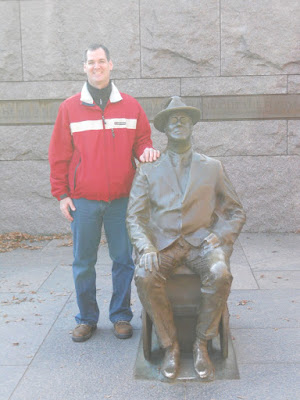
One of several large commemorative prints marking the enactment on March 30, 1870, of the Fifteenth Amendment, and showing the parade celebrating it which was held in Baltimore on May 19 the same year. The amendment declared that the right to vote "shall not be denied or abridged by the United States or by any State on account of race, color, or previous condition of servitude." Here the parade winds down Monument Street from Baltimore's Washington Monument. In the left distance is the spire of the First Presbyterian Church. Heading the parade are a small troop of black Zouaves, holding rifles across their shoulders. They are followed by several men on horseback wearing top hats and sashes, several floats, and more soldiers. The sidewalks are lined with onlookers, many of them black. Framing the central image are a series of vignettes. At left are portrait busts of the late Pennsylvania representative and champion of black suffrage Thaddeus Stevens, Maryland representative Henry Winter Davis, author of the Wade-Davis Bill, and Massachusetts senator Charles Sumner. At right are busts of distinguished blacks Martin Robinson Delany, Frederick Douglass, and Hiram R. Revels. In the upper left corner of the print is an antebellum plantation scene, where a mustachioed overseer supervises slaves picking cotton. Nearby is an elegant house surrounded by palm trees. Beneath the scene are the words, "We are in bondage. O deliver us!" In contrast, the right hand corner holds a Civil War scene of black troops rushing into battle, with the words "We fought for Liberty, we now enjoy" below. In the center, above the parade scene, appear busts of (left to right) Lincoln, Baltimore jurist Hugh Lennox Bond, abolitionist martyr John Brown, Vice president Schuyler Colfax, and President Ulysses S. Grant. The three busts in the center rest on crossed laurel branches and flags. In the lower corners stand two parade groups of black men wearing Masonic sashes and aprons. They carry banners decorated with allegorical figures as well as the portraits of Lincoln, Grant, and Swiss patriot William Tell and his son. Between these groups are two small scenes: a black schoolroom with the words "Education will be our pride," and a black preacher before his congregation, with the words, "The day of Jubilee has come."

Another of several large prints commemorating the celebration in Baltimore of the enactment of the Fifteenth Amendment. (See also nos. 1870-2 and 1870-3.) A group of black men, on horseback and wearing top hats, sashes, and badges, lead a procession. Behind them follow black soldiers and others carrying American flags and banners with portraits of an Indian brave, a black military officer, and Liberty. A small float with a crowned woman under a canopy also follows. On either side of the picture are two columns, "Education" and "Science," on top of which rest ballot boxes wreathed in oak leaves. The columns are connected by arches with the legend "The Right of Citizens of the United States to Vote Shall Not Be Denied or Abridged by the United States or Any State on Account of Race Color or Condition of Servitude." At left, beside the "Education" column, is a classroom scene where a black man teaches two black children geography. Below this scene is a bust portrait of Frederick Douglass. At right, near the "Science" column, are two black men at work. One, a stonemason, carves a large column. The other, a smith, stands at his anvil. Below this scene is a bust portrait of Mississipi senator Hiram R. Revels. The upper register of the print features portraits of white benefactors. In the center is an oval portrait of Lincoln, framed in oak leaves. It is decorated with an eagle and American flags, and flanked by seated figures of History or Learning (left) and Columbia or Liberty (right) with a shield, Phrygian cap, and sword. At the far left are busts of President Ulysses S. Grant and Vice President Schuyler Colfax, and at far right busts of abolitionist martyr John Brown and Baltimore jurist Hugh Lenox Bond.
Courtesy Library of Congress





























